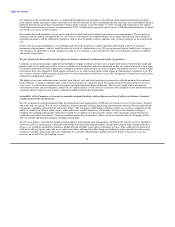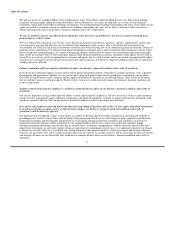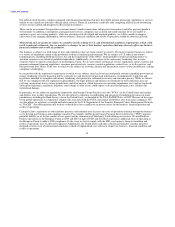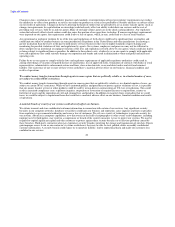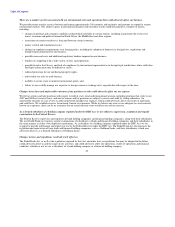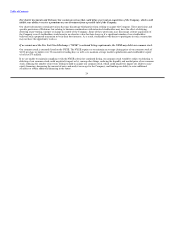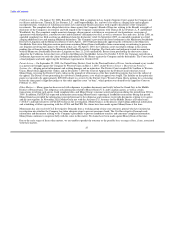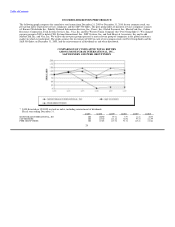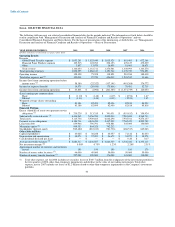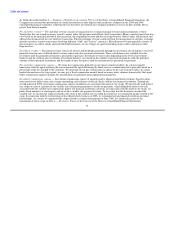MoneyGram 2010 Annual Report Download - page 26
Download and view the complete annual report
Please find page 26 of the 2010 MoneyGram annual report below. You can navigate through the pages in the report by either clicking on the pages listed below, or by using the keyword search tool below to find specific information within the annual report.
Table of Contents
The recent Dodd-Frank Act increases the regulation of financial services companies generally, including non-bank financial
companies supervised by the Federal Reserve.
The Dodd-Frank Act increases the regulation and oversight of the financial services industry. The Dodd-Frank Act addresses, among
other things, systemic risk, capital adequacy, deposit insurance assessments, consumer financial protection, interchange fees, derivatives,
lending limits, thrift charters, changes among the bank regulatory agencies, and the ability to conduct business with holding company
affiliates. Many of the provisions of the Dodd-Frank Act require studies and regulations. The Dodd-Frank Act requires enforcement by
various governmental agencies, including the new Bureau. The new legislation and implementing regulations may increase our costs of
compliance, and may require changes in the way we conduct business. We cannot predict the effects of this broad legislation or the
regulations to be adopted pursuant to the Dodd-Frank Act.
We will be subject to various provisions of the Consumer Financial Protection Act of 2010 adopted as part of the Dodd-Frank Act,
which will result in a new regulator with new and expanded compliance requirements, which is likely to increase our costs.
The Dodd-Frank Act establishes the Bureau, which will affect our business, even if we are not deemed a subsidiary of a bank or financial
holding company. Money transmitters such as the Company will be required to provide additional consumer information and disclosures.
The Bureau is charged with studying and drafting standards to address existing prices and fees at locations where our services are offered
and adopt error resolution standards. The Bureau and the regulations it will adopt are likely to necessitate operational changes and
additional costs, but we cannot predict its effects upon us or our business at this time.
Failure to maintain effective internal controls in accordance with Section 404 of the Sarbanes-Oxley Act could have a material
adverse effect on our business.
We are required to certify and report on our compliance with the requirements of Section 404 of the Sarbanes-Oxley Act, which requires
annual management assessments of the effectiveness of our internal control over financial reporting and a report by our independent
registered public accounting firm addressing the effectiveness of our internal control over financial reporting. If we fail to maintain the
adequacy of our internal controls, as such standards are modified, supplemented or amended from time to time, we may not be able to
ensure that we can conclude on an ongoing basis that we have effective internal controls over financial reporting in accordance with
Section 404. In order to achieve effective internal controls we may need to enhance our accounting systems or processes, which could
increase our cost of doing business. Any failure to achieve and maintain an effective internal control environment could have a material
adverse effect on our business.
We have significant overhang of salable convertible preferred stock relative to the public float of our common stock.
The trading market for our common stock was first established in June 2004. The float in that market now consists of approximately
83,400,000 shares out of a total of 83,620,522 shares issued and outstanding as of December 31, 2010. The Series B Stock issued to the
Investors is convertible into shares of common stock or common equivalent stock at the price of $2.50 per common share, subject to anti-
dilution rights. Pursuant to the Registration Rights Agreement entered into between the Company and the Investors at the closing of the
2008 Recapitalization, on December 14, 2010, we filed a registration statement on Form S-3 with the SEC that permits the offer and sale
by the Investors of all of the Series B Stock that they hold, as well as any common stock or D Stock into which the B-1 Stock may be
converted. The registration statement also permits the Company to offer and sell up to $500 million of its common stock, preferred stock,
debt securities or any combination of these, from time to time, subject to market conditions and the Company's capital needs. Sales of a
substantial number of shares of our common stock, or the perception that significant sales could occur (particularly if sales are
concentrated in time or amount), may depress the trading price of our common stock.
23





